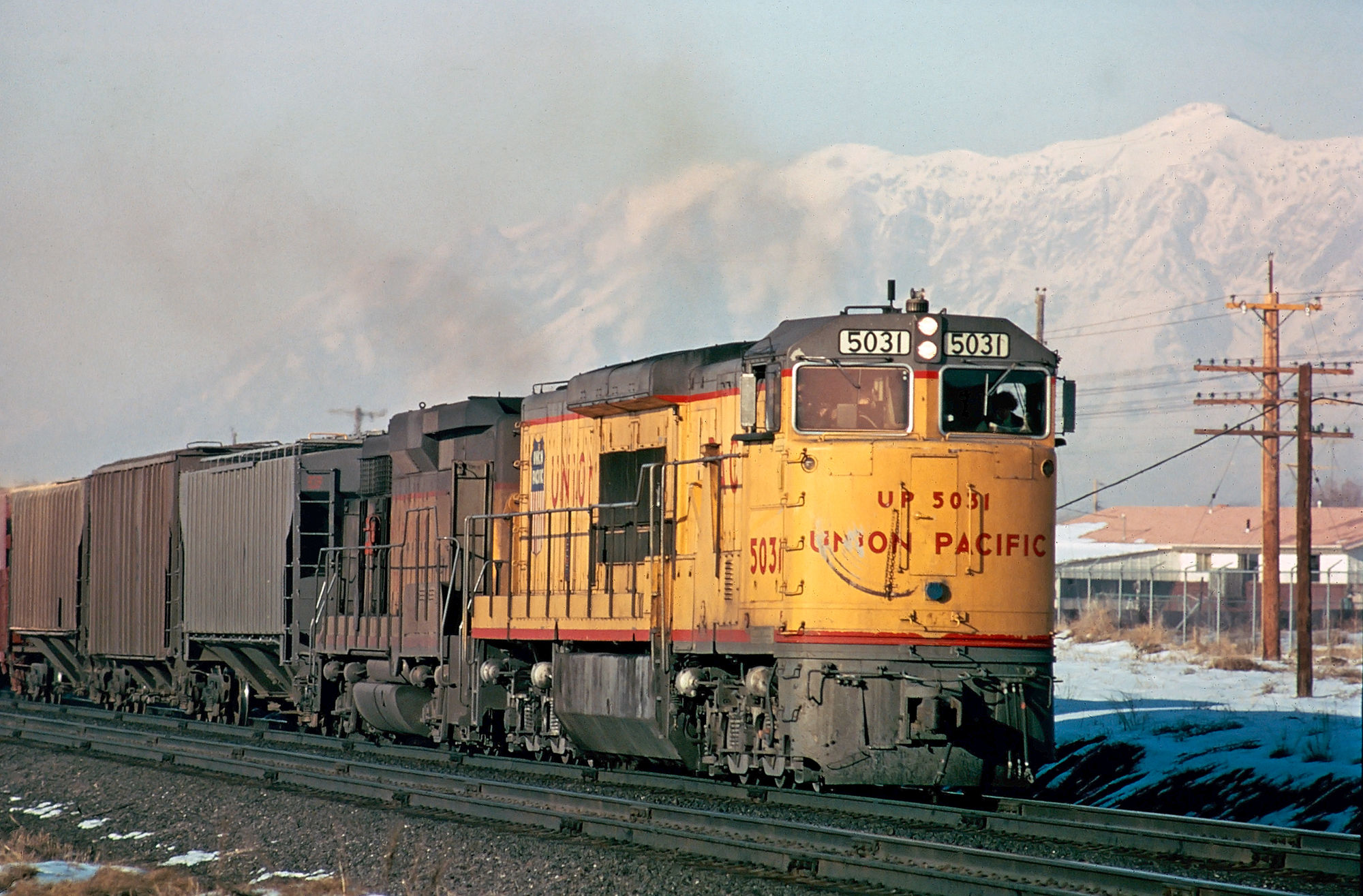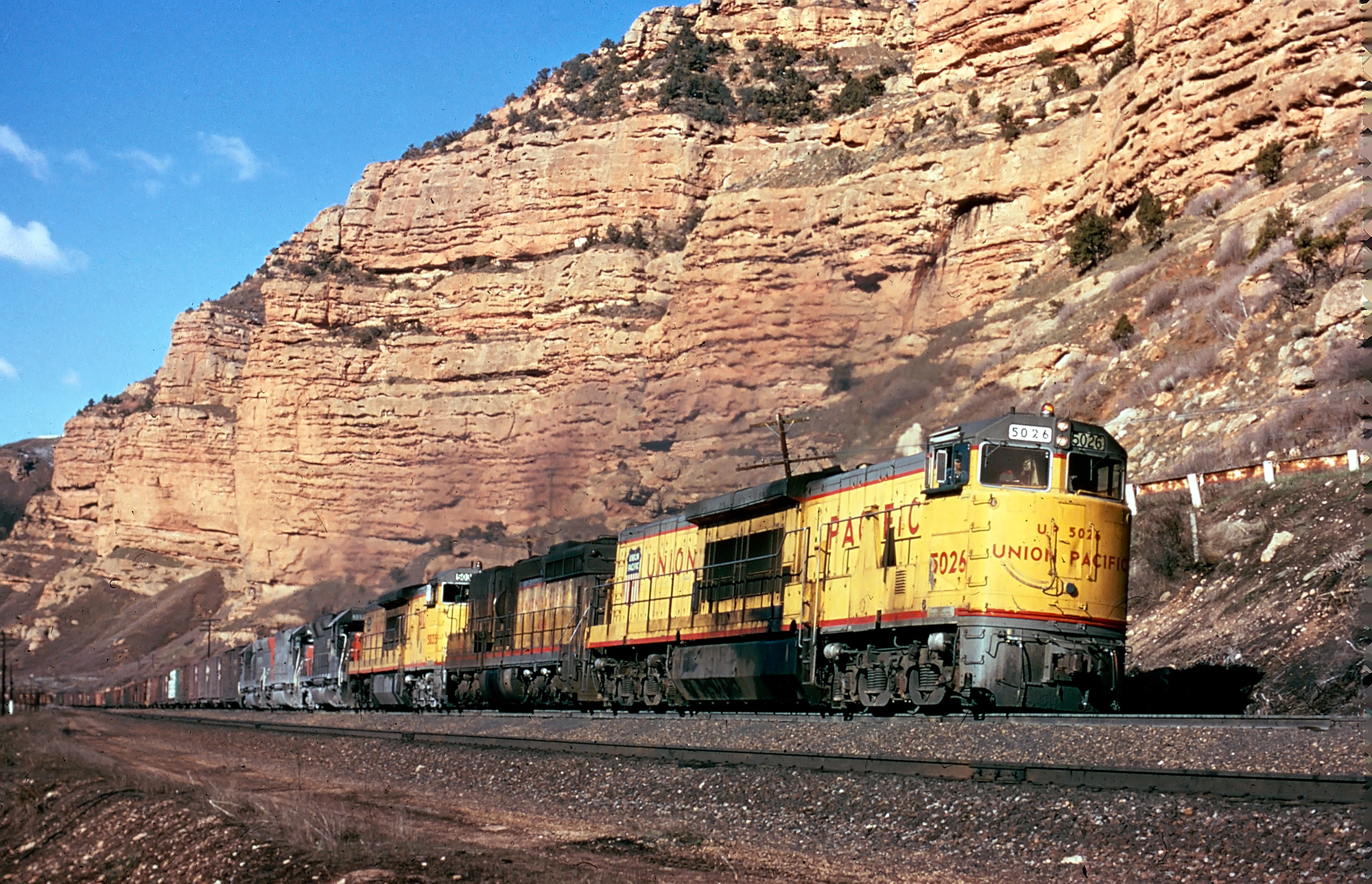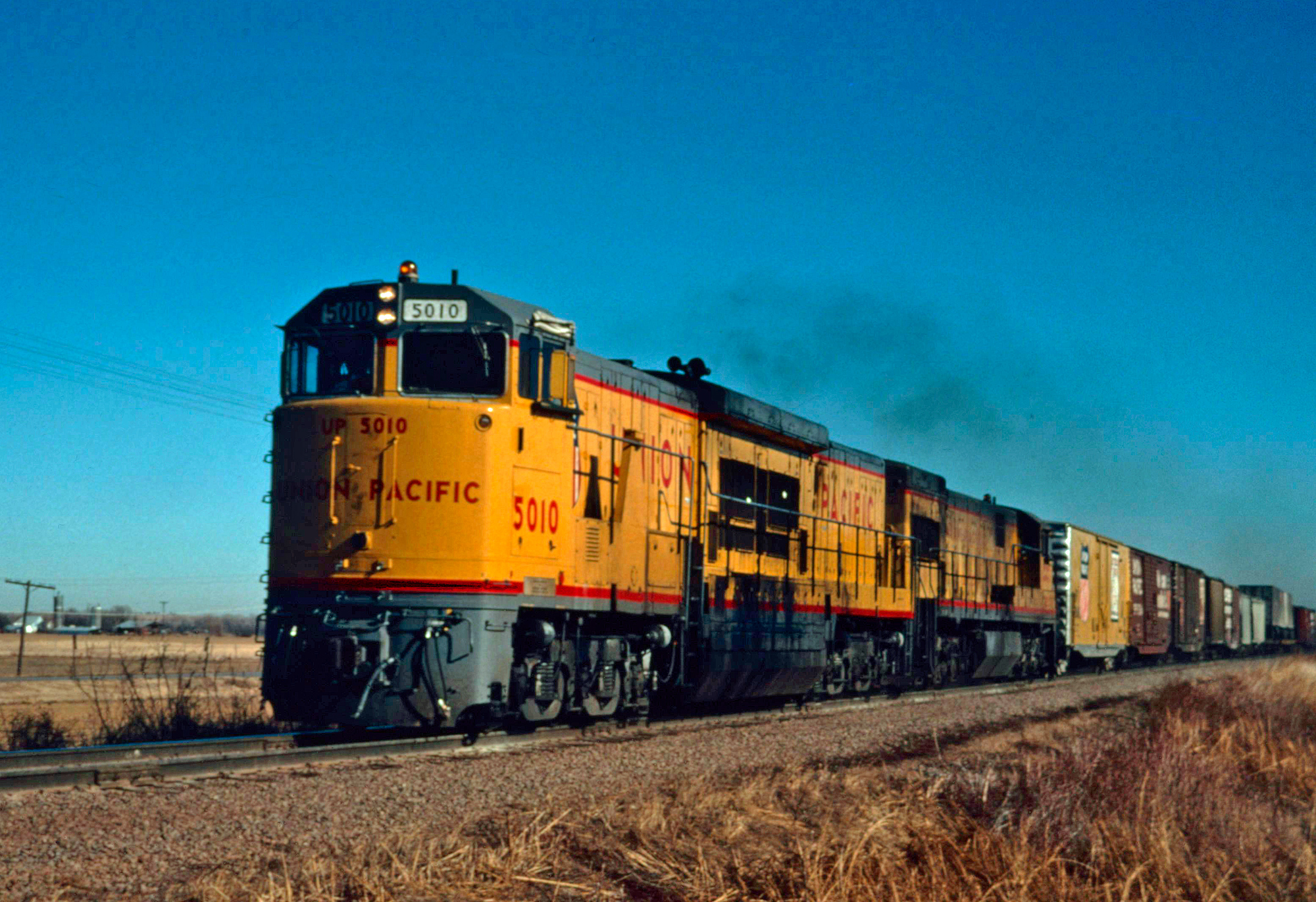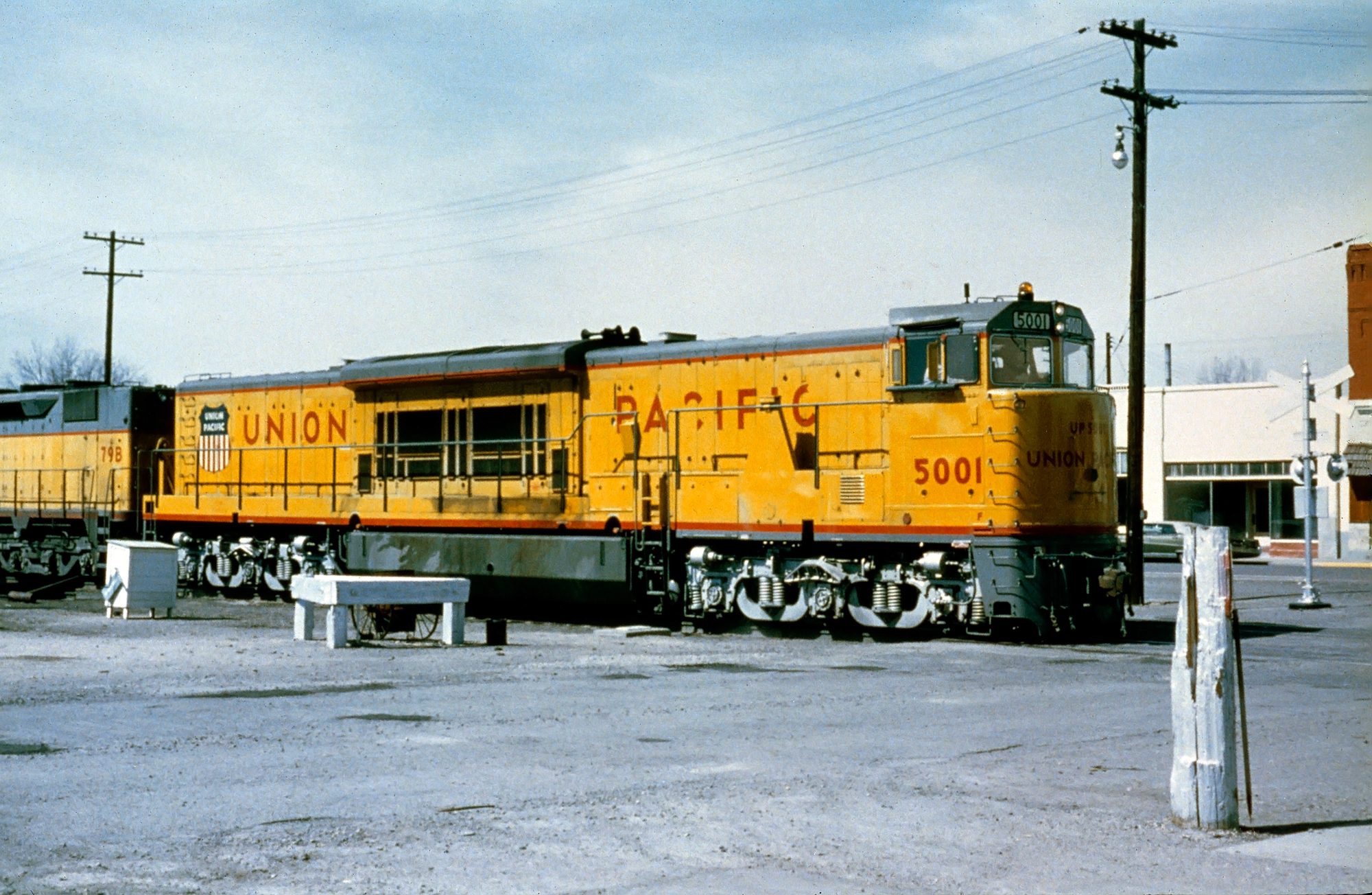GE "U50C" Locomotives: Specs, Horsepower, History
Last revised: December 31, 2024
By: Adam Burns
The U50C was General Electric's successor to its earlier U50 design of 1963. As Brian Solomon notes in his book, "GE Locomotives," improvements with the 7FDL prime mover enabled the company to offer this high horsepower variant with 12-cylinder power plants in place of the standard 16.
In doing so, the U50C offered lower maintenance costs and better fuel economy. Nevertheless, it still proved a shaky design and the fleet operated for less than 10 years before retirement.
History
While the 1960s are often remembered as the great horsepower race between Alco, GE, and EMD there was another ongoing by an individual railroad, Union Pacific.
That decade saw the western carrier experimenting with numerous one-off designs like the C-855, DH-643 (diesel hydraulic), DD35 and DD35A, U50, U50C, gas turbines (GE/Alco products), and the DDA40X.
All of these locomotives offered horsepower ratings of 5,000 or greater (except for the 4,300 horsepower DH-643) as UP sought a locomotive that could reduce operating costs.
Most were essentially two locomotives under a single hood (duel powerplants), and not particularly successful. There were two exceptions, the gas turbines and EMD's variants (DD35 and DDA40X) which were successful and spent many years in service.
Photos
 Union Pacific U50C #5031 and a GP30B in service near Ogden, Utah, circa 1974. American-Rails.com collection.
Union Pacific U50C #5031 and a GP30B in service near Ogden, Utah, circa 1974. American-Rails.com collection.The U50C's use of 12-cylinder engines, and sporting a pair of C-C trucks (requisitioned from aging gas turbines), enabled the locomotive's length to be reduced by 4 1/2 feet over the earlier U50 design.
As Louis Marre notes in his book, "Diesel Locomotives: The First 50 Years," GE engineers completely changed the layout of interior components in the U50C; its radiators were located in the center with the generators near the end. The U50's, by contrast, were placed in the opposite locations.
Top Speed
The U50C was designed for speed and could operate at 80 mph, slightly faster than most standard line U-boats which were rated at 70 mph.
While the U50 weighed in at 558,000 pounds (279 tons), the U50C weighed just 417,000 pounds (208 1/2 tons). This reduction, an impressive 70 1/2 tons, greatly reduced wear on the track and roadbed.
 Union Pacific U50C's (along with an SD24B) and Southern Pacific SD45's (along with an SD45T-2) lead an eastbound freight through Utah's Echo Canyon, circa 1974. American-Rails.com collection.
Union Pacific U50C's (along with an SD24B) and Southern Pacific SD45's (along with an SD45T-2) lead an eastbound freight through Utah's Echo Canyon, circa 1974. American-Rails.com collection.Unfortunately, it did little to remedy the locomotive's other design flaws, most notably the use of aluminum wiring in the electrical system, which easily caught fire.
GE engineers scrambled to correct this problem, which proved so severe that fire to four new units in 1974 caused their near immediate retirement.
The builder looked to potentially have the wiring replaced with copper, a project that would have been outsourced to Morrison-Knudsen. Unfortunately, this proved too expensive to carry out.
 General Electric U50C #5010 leads a general merchandise westbound at Salina, Kansas on January 16, 1976. American-Rails.com collection.
General Electric U50C #5010 leads a general merchandise westbound at Salina, Kansas on January 16, 1976. American-Rails.com collection.As it turned out, fire wasn't the only major issue; the former GTEL trucks proved insufficient to handle the locomotive's weight, as cracks were later discovered in these frames. It seems that every conceivable problem was happening with the U50Cs.
Aside from the issues mentioned above the locomotives also suffered from dynamic brake issues, oil pressure problems, and leaking water coolant.
Perhaps Union Pacific regretted ordering such a large batch of these experimental locomotives (40) although likely trusted General Electric's ability to correct the issues.
Data Sheet and Specifications
| Entered Production | 10/1969 (Union Pacific #5000) |
| Years Produced | 10/1969 - 11/1971 |
| GE Class | U50C |
| Engine | 7FDL12 (2) |
| Engine Builder | General Electric |
| Horsepower | 5,000 |
| RPM | 1050 |
| Length | 79' 0" |
| Height (Top Of Rail To Top Of Cab) | 15' 10 3/4" |
| Width | 9' 11" |
| Weight | 417,000 Lbs |
| Fuel Capacity | 6,000 Gallons |
| Air Compressor | 3CDC (Westinghouse) |
| Air Brake Schedule | 26L (Westinghouse) |
| Trucks | C-C |
| Truck Type | GTEL8500 |
| Truck Wheelbase | 14' 6" |
| Wheel Size | 40" |
| Traction Motors | 752 (6), GE |
| Traction Generator | GT588, GE |
| Auxiliary Generator | GY27, GE |
| MU (Multiple-Unit) | Yes |
| Dynamic Brakes | Yes |
| Gear Ratio | 74:18* |
| Tractive Effort/Starting | 109,000 Lbs |
| Tractive Effort/Continuous | 88,000 Lbs at 10 mph |
| Top Speed | 80 mph |
* The gear ratio could not be verified among the available sources in my collection. The ratio listed may not be correct. The locomotives were rated at 80 mph running according to Mr. McDonnell's book.
Production Roster
(Total Built = 40)
| Owner | Road Number | Serial Number | Order Number | Completion Date | Quantity |
|---|---|---|---|---|---|
| Union Pacific | 5000-5002 | 37139-37141 | 5000 | 10/1969-11/1969 | 3 |
| Union Pacific | 5003-5011 | 37142-37150 | 5000 | 3/1970-5/1970 | 9 |
| Union Pacific | 5012-5016 | 37151-37155 | 5000 | 11/1970-12/1970 | 5 |
| Union Pacific | 5017-5019 | 37156-37158 | 5000 | 1/1971-2/1971 | 3 |
| Union Pacific | 5020-5039 | 37273-37292 | 5005 | 5/1971-11/1971 | 20 |
Sources
- Marre, Louis A. Diesel Locomotives: The First 50 Years, A Guide To Diesels Built Before 1972. Milwaukee: Kalmbach Publishing Company, 1995.
- McDonnell, Greg. U-boats. Toronto: Stoddart Publishing, 1994.
- Pinkepank, Jerry A. Diesel Spotter's Guide. Milwaukee: Kalmbach Publishing Company, 1967.
- Solomon, Brian. GE Locomotives: 110 Years Of General Electric Motive Power. St. Paul: MBI Publishing, 2003.
 Union Pacific U50C #5001 and DD35 #79B at Kearney, Nebraska, circa 1975. Bob Hicks photo. American-Rails.com collection.
Union Pacific U50C #5001 and DD35 #79B at Kearney, Nebraska, circa 1975. Bob Hicks photo. American-Rails.com collection.Final Years
While its Universal line did have its issues, and GE had yet to reach EMD's level of ruggedness or efficiency, the company backed all of its product with warranties and field work.
In the end, nothing could be done to correct the U50C's problems; #5000-5017 were retired in March, 1977 and remaining units scrapped in February, 1978.
Despite the many setbacks, these unique U-boats they were an interesting footnote in the high horsepower race of the 1960's. Alas, none were preserved.
Recent Articles
-
Kansas ~ Murder Mystery ~ Dinner Train Rides
Jan 21, 26 01:40 PM
Kansas, known for its sprawling wheat fields and rich history, hides a unique gem that promises both intrigue and culinary delight—murder mystery dinner trains. -
Florida ~ Murder Mystery ~ Dinner Train Rides
Jan 21, 26 01:05 PM
Florida, known for its vibrant culture, dazzling beaches, and thrilling theme parks, also offers a unique blend of mystery and fine dining aboard its murder mystery dinner trains. -
New Hampshire ~ Murder Mystery ~ Dinner Train Rides
Jan 21, 26 12:07 PM
The state's murder mystery trains stand out as a captivating blend of theatrical drama, exquisite dining, and scenic rail travel. -
New Jersey Dinner Train Rides In Woodstown
Jan 21, 26 11:20 AM
For visitors who love experiences (not just attractions), Woodstown Central’s dinner-and-dining style trains have become a signature offering—especially for couples’ nights out, small friend groups, a… -
Montana's Dinner Train Rides Near Lewistown!
Jan 21, 26 10:40 AM
The Charlie Russell Chew Choo turns an ordinary rail trip into an evening event: scenery, storytelling, live entertainment, and a hearty dinner served as the train rumbles across trestles and into a t… -
Kansas Valentine's Train Rides
Jan 21, 26 10:09 AM
While the railroad’s regular-season excursions are a big draw, the A&SV also shines with its calendar of themed trains—none more romantic than its Valentine’s Day special. -
Alabama Valentine's Train Rides
Jan 21, 26 09:39 AM
The Heart of Dixie Railroad Museum (HoDRM) is the kind of place where history isn’t parked behind ropes—it moves. This includes Valentine's Day weekend, where the museum hosts a wine pairing special. -
Wisconsin's Dinner Train Rides In North Freedom!
Jan 20, 26 01:55 PM
Featured here is a practical guide to Mid-Continent’s dining train concept—what the experience is like, the kinds of menus the museum has offered, and what to expect when you book. -
New York's Dinner Train Rides In The Adirondacks!
Jan 20, 26 12:41 PM
Operating over a restored segment of the former New York Central’s Adirondack Division, the Adirondack Railroad has steadily rebuilt both track and public interest in passenger rail across the region. -
Pennsylvania "Dinner Train" Rides In Boyertown!
Jan 20, 26 12:04 PM
With beautifully restored vintage equipment, carefully curated menus, and theatrical storytelling woven into each trip, the Colebrookdale Railroad offers far more than a simple meal on rails. -
New York ~ Murder Mystery ~ Dinner Train Rides
Jan 20, 26 12:03 PM
New York State, renowned for its vibrant cities and verdant countryside, offers a plethora of activities for locals and tourists alike, including murder mystery train rides! -
Pennsylvania ~ Murder Mystery ~ Dinner Train Rides
Jan 20, 26 11:48 AM
Pennsylvania, steeped in history and industrial heritage, offers a prime setting for a unique blend of dining and drama: the murder mystery dinner train ride. -
Florida Valentine's Train Rides
Jan 20, 26 11:46 AM
For couples looking for something different this Valentine’s Day, the museum’s signature romantic event is back: the Valentine Limited, returning February 14, 2026—a festive evening built around a tra… -
Connecticut Valentine's Train Rides
Jan 20, 26 11:43 AM
Operated by the Valley Railroad Company, the attraction has been welcoming visitors to the lower Connecticut River Valley for decades, preserving the feel of classic rail travel while packaging it int… -
Texas Dinner Train Rides At The TSR!
Jan 19, 26 12:30 PM
Today, TSR markets itself as a round-trip, four-hour, 25-mile journey between Palestine and Rusk—an easy day trip (or date-night centerpiece) with just the right amount of history baked in. -
Iowa's Dinner Train Rides In Boone!
Jan 19, 26 12:28 PM
If you’ve ever wished you could pair a leisurely rail journey with a proper sit-down meal—white tablecloths, big windows, and countryside rolling by—the Boone & Scenic Valley Railroad & Museum… -
Ohio Dinner Train Rides At The CVSR!
Jan 19, 26 12:27 PM
While the railroad is well known for daytime sightseeing and seasonal events, one of its most memorable offerings is its evening dining program—an experience that blends vintage passenger-car ambience… -
Missouri's Dinner Train Rides In Branson!
Jan 19, 26 12:21 PM
Nestled in the heart of the Ozarks, the Branson Scenic Railway offers one of the most distinctive rail experiences in the Midwest—pairing classic passenger railroading with sweeping mountain scenery a… -
Virginia Valentine's Train Rides
Jan 19, 26 12:15 PM
If you’ve ever wanted to slow life down to the rhythm of jointed rail—coffee in hand, wide windows framing pastureland, forests, and mountain ridges—the Virginia Scenic Railway (VSR) is built for exac… -
Maryland Valentine's Train Rides
Jan 19, 26 12:12 PM
The Western Maryland Scenic Railroad (WMSR) delivers one of the East’s most “complete” heritage-rail experiences: and also offer their popular dinner train during the Valentine's Day weekend. -
Indiana's Dinner Train Rides In Jasper!
Jan 18, 26 01:54 PM
In the rolling hills of southern Indiana, the Spirit of Jasper offers one of those rare attractions that feels equal parts throwback and treat-yourself night out: a classic excursion train paired with… -
New Mexico's Dinner Train Rides
Jan 18, 26 01:37 PM
If your heart is set on clinking glasses while the desert glows at sunset, you can absolutely do that here—just know which operator offers what, and plan accordingly. -
New Hampshire ~ Murder Mystery ~ Dinner Train Rides
Jan 18, 26 01:10 PM
The state's murder mystery trains stand out as a captivating blend of theatrical drama, exquisite dining, and scenic rail travel. -
New York Valentine's Train Rides
Jan 18, 26 12:32 PM
At its best, the Adirondack Railroad delivers exactly what railfans and casual riders alike hope for: vintage coaches, classic depots, rivers and forests right outside the window. -
Washington Valentine's Train Rides
Jan 18, 26 10:50 AM
Whether you’re a dedicated railfan chasing preserved equipment or a couple looking for a memorable night out, CCR&M offers a “small railroad, big experience” vibe—one that shines brightest on its spec… -
Colorado Valentine's Train Rides
Jan 18, 26 10:49 AM
The Royal Gorge Route Railroad is the kind of trip that feels tailor-made for railfans and casual travelers alike, including during Valentine's weekend. -
Georgia Valentine's Train Rides
Jan 18, 26 10:42 AM
f you’ve ridden the SAM Shortline, it’s easy to think of it purely as a modern-day pleasure train—vintage cars, wide South Georgia skies, and a relaxed pace that feels worlds away from interstates and… -
New Jersey ~ Murder Mystery ~ Dinner Train Rides
Jan 17, 26 01:16 PM
There are currently no murder mystery dinner trains available in New Jersey although until 2023 the Cape May Seashore Lines offered this event. Perhaps they will again soon! -
West Virginia Dinner Train Rides In Elkins!
Jan 17, 26 01:08 PM
The D&GV offers the kind of rail experience that feels purpose-built for railfans and casual travelers. -
Virginia Dinner Train Rides In Staunton!
Jan 17, 26 11:55 AM
If you’ve ever wished you could pair a classic scenic train ride with a genuinely satisfying meal—served at your table while the countryside rolls by—the Virginia Scenic Railway was built for you. -
Florida Easter Train Rides
Jan 17, 26 10:23 AM
The cold weather rarely invades Florida and the state nearly always warm and balmy early spring temperatures. Learn more about where you can find Easter-themed train rides across the Sunshine State. -
Ohio Easter Train Rides
Jan 17, 26 10:13 AM
Ohio is home to several museums and excursion trains preserving the state's rich railroading heritage. A few of these locations host Easter-themed train rides each spring. -
Massachusetts Valentine's Train Rides
Jan 17, 26 09:58 AM
The Cape Cod Central Railroad (CCCR) blends classic New England scenery with heritage equipment, narrated sightseeing, and some of the region’s best-known “rails-and-meals” experiences. -
California Valentine's Train Rides
Jan 17, 26 09:53 AM
Operating out of West Sacramento, this excursion railroad has built a calendar that blends scenery with experiences—wine pours, themed parties, dinner-and-entertainment outings, and seasonal specials… -
South Carolina Dinner Train Rides
Jan 16, 26 11:13 PM
There is only location in the Palmetto State offering a true dinner train experience can be found at the South Carolina Railroad Museum. Learn more here. -
Rhode Island Dinner Train Rides
Jan 16, 26 11:01 PM
Despite its small size, Rhode Island is home to one popular dinner train experience where guests can enjoy the breathtaking views of Aquidneck Island. -
Pennsylvania's Thomas The Train Rides
Jan 16, 26 04:13 PM
"A Day Out With Thomas” train rides offer a unique opportunity for children and their families to engage in a magical and memorable experience, setting the stage for a full day of fun and adventure. -
Illinois's Thomas The Train Rides
Jan 16, 26 02:23 PM
In Illinois, the "A Day Out With Thomas" event offers a unique chance for families to immerse themselves in the enchanting world of Thomas and friends, creating memories that last a lifetime. -
New Jersey's Thomas The Train Rides
Jan 16, 26 02:11 PM
Here's a comprehensive guide to what you can expect at Day Out With Thomas events in New Jersey. -
Texas ~ Murder Mystery ~ Dinner Train Rides
Jan 16, 26 01:54 PM
Here’s a comprehensive look into the world of murder mystery dinner trains in Texas. -
Connecticut ~ Murder Mystery ~ Dinner Train Rides
Jan 16, 26 01:26 PM
All aboard the intrigue express! One location in Connecticut typically offers a unique and thrilling experience for both locals and visitors alike, murder mystery trains. -
New Hampshire Dinner Train Rides In N. Conway!
Jan 16, 26 10:47 AM
Tucked into the heart of New Hampshire’s Mount Washington Valley, the Conway Scenic Railroad is one of New England’s most beloved heritage railways -
Oregon Dinner Train Rides Near Mt. Hood!
Jan 16, 26 10:44 AM
The Mt. Hood Railroad is the moving part of that postcard—a century-old short line that began as a working railroad. -
Maryland's - Wine Tasting - Train Rides
Jan 15, 26 02:59 PM
This article delves into the enchanting world of wine tasting train experiences in Maryland, providing a detailed exploration of their offerings, history, and allure. -
Colorado's - Wine Tasting - Train Rides
Jan 15, 26 02:46 PM
To truly savor these local flavors while soaking in the scenic beauty of Colorado, the concept of wine tasting trains has emerged, offering both locals and tourists a luxurious and immersive indulgenc… -
Iowa ~ Wine Tasting ~ Train Rides
Jan 15, 26 02:36 PM
The state not only boasts a burgeoning wine industry but also offers unique experiences such as wine by rail aboard the Boone & Scenic Valley Railroad. -
Georgia's Wine Train Rides In Cordele!
Jan 15, 26 02:26 PM
While the railroad offers a range of themed trips throughout the year, one of its most crowd-pleasing special events is the Wine & Cheese Train—a short, scenic round trip designed to feel like a t… -
Indiana ~ Murder Mystery ~ Dinner Train Rides
Jan 15, 26 02:22 PM
This piece explores the allure of murder mystery trains and why they are becoming a must-try experience for enthusiasts and casual travelers alike. -
Ohio ~ Murder Mystery ~ Dinner Train Rides
Jan 15, 26 02:10 PM
The murder mystery dinner train rides in Ohio provide an immersive experience that combines fine dining, an engaging narrative, and the beauty of Ohio's landscapes. -
Nevada Dinner Train Rides In Ely!
Jan 15, 26 02:01 PM
If you’ve ever wished you could step through a time portal into the hard-working world of a 1900s short line the Nevada Northern Railway in Ely is about as close as it gets.















































